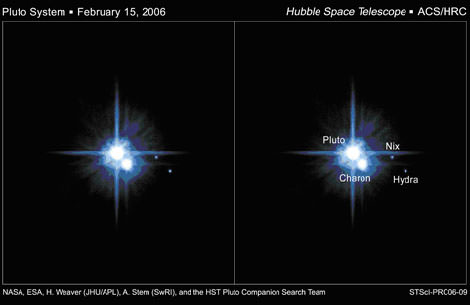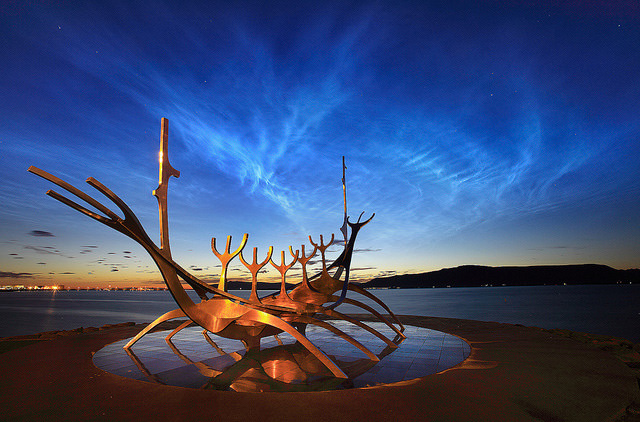Early Tuesday morning (August 9, 2011,) the Sun erupted with the largest solar flare of Cycle 24, registering as an X7-class flare. This flare had an X-ray magnitude of X6.9, meaning it was more than 3 times larger than the previous largest flare of this solar cycle – the X2.2 that occurred on Feb 15, 2011, NASA said. The source was Sunspot 1263 which is nearing the western limb of the Sun, and because of its location, scientists do not anticipate that this explosion will hit Earth directly. Therefore, the impact on communications and electric grids will likely (and luckily) be minimal.
Continue reading “Sun Erupts with Largest Solar Flare of the Cycle”
Ring System Around Pluto?
[/caption]
With the New Horizons spacecraft on its way to Pluto, there may be an intriguing additional task for the mission’s science team: look for a potential ring around Pluto and its moons. Researchers at The Universidade Estadual Paulista in Brazil have recently submitted a paper for publication in which they explore the possibility of a ring system around the Pluto-Charon system. In their paper, the team discusses the effects of micrometeoroid impacts on Nix and Hydra and how the resulting dust particles could form a ring around Pluto. The team also investigates forces, such as the solar wind, which would dissipate said ring system.
Pryscilla Maria Pires dos Santos and her team provide an exhaustive list of calculations in their paper which estimates the ring system to have a diameter of nearly 16,000 kilometers – well outside the orbits of Nix and Hydra. Based on their calculations, Pires dos Santos state that despite nearly 50% of the ring’s mass being dissipated within a year, a tenuous ring system can be maintained by the dust expelled by micrometeoroid impacts.
Additional data presented in the paper places the rings “optical depth” as being several orders of magnitude fainter than even Jupiter’s rings. (Yes, Jupiter has a ring system!) While ground-based observatories and even the Hubble Space Telescope haven’t detected the ring system Pires dos Santos et al. are hopeful that the New Horizons mission will provide data to validate their theoretical models. New Horizons has a dust counter capable of measuring dust grains with a minimum mass of 10-12 grams, which should provide the data required to support or refute the team’s models.
Pires dos Santos mentions: “It is worth to point out that the interplanetary environment in the outer Solar System is not well known. Many assumptions have to be made in order to estimate a normal optical depth of a putative ring encompassing the orbits of Nix and Hydra.”
If you’d like to read the full paper, you can access it (for free) at: http://arxiv.org/PS_cache/arxiv/pdf/1108/1108.0712v1.pdf
Source: arXiv:1108.0712v1 [astro-ph.EP]
NIAC is Back: NASA Funds 30 Innovative Ideas that Just Might Work
[/caption]
What do these three things have in common: space debris elimination using an air gun, a heat shield made from lunar regolith and lightweight space structures made from ultra-light nanomaterials called “Photonic Muscle?”
They are just three of thirty new concepts that NASA has provided funding to move innovative ideas from formulation to implementation under the NASA Innovative Advanced Concepts, or NIAC, program. Some of the concepts are new ways of dealing with persistent problems; others are completely new ideas, with some in the category that sound so crazy, they just might work.
“These advanced concepts selected for study under NIAC were chosen based on their potential to transform or significantly alter our current approaches to launching future space missions, or building and operating space systems,” said Dr. Bobby Braun, NASA’s Chief Technologist, during a teleconference on Aug. 8, 2011.
NIAC—formerly known as the NASA Institute for Advanced Concepts – is back after being cut in 2007 due to budget constraints. The program began in 1998 and the closure of the think-tank-type of program was cause for dismay by those who believed part of NASA’s mission is to spur research and innovation.
“This was previously an outstanding program at NASA and I am excited to be part of the team that is bringing NIAC back,” said Braun. “This is really part of a small change going on within NASA to take it back to its roots with a focus on advanced technology and innovation.”
Braun added that technology and innovation goes hand in hand with space exploration. “Visionary thinking is important for maintaining our leadership in space,” he said.
Each proposal will receive approximately $100,000 for one year to advance the innovative space technology concept and help NASA meet operational and future mission requirements.
NASA received over 150 different proposals for funding, and the 30 were chosen based on their technical merits and their potential to mature into the transformative capabilities NASA is looking for to improve current space mission operations.
“Some of the proposals are risky, somewhat out-of-the-box ideas and very advanced system concepts that have the potential to revolutionize our missions in the future,” said Joe Parrish, director of the Early Stage Innovation division at NASA’s Office of the Chief Technologist in the Space Technology division. “We recognize that in order to make big gains, sometimes we are going to accept some risks. NIAC is the greatest example of an effort to really look at very far-reaching activities and consciously and willingly take risks and look for big rewards to those risks.”
Some of the winning proposals include advanced propulsion and power systems for space, protecting humans from radiation in space, 3-D printing to construct mini spacecraft, and using flywheels to power a spacesuit.
“The most meritorious proposals allow us to look at many ways to address these problems, any of which would be breakthrough technologies,” said Parrish.
These first “new” NIAC projects were chosen based on being technically substantiated, and they could hopefully mature within about 10 years from mission infusion.
NASA anticipates the funding starting dates to be in early September 2011. “We hope to have NIAC studies on an annual basis, and concepts that do well in their first year could receive up $500,000 for up to two years of additional research,” said Jay Falker, NIAC program executive.
The previous NIAC allowed only non-NASA employees to apply, but the new incarnation permits NASA-based personnel to seek funding for their ideas.
In 2008, the National Research Council conducted a review of NIAC’s effectiveness and made concluded that NASA and the US would be well served by maintaining a mechanism to investigate visionary, far-reaching advanced concepts as part of the agency’s mission. Following an October 2009 hearing by the U.S. House of Representatives Subcommittee on Space and Aeronautics, NASA re-established the NIAC program during fiscal year 2011.
Some of the avant-garde and risky ideas funded under the previous NIAC included the space elevator — a cable to ferry equipment from Earth into orbit — and a solar shield to be unfurled in space to deflect sunlight and counter global warming.
The new concepts announced yesterday include both well-known issues and completely new designs. For example, space debris is a well-identified issue that NASA’s been working on, but using an air gun from a high altitude balloon to shoot pulses into the upper atmosphere to slow down debris is “an approach that’s completely novel to a problem we’ve known about,” Falker said.
See the complete list of winning concepts here. Got an idea? More information about NIAC can be found here.
Over the next few weeks, we hope to feature several of these concepts in more detail.
You can follow Universe Today senior editor Nancy Atkinson on Twitter: @Nancy_A. Follow Universe Today for the latest space and astronomy news on Twitter @universetoday and on Facebook.
Juno Spacecraft Honors Those Who Started It All
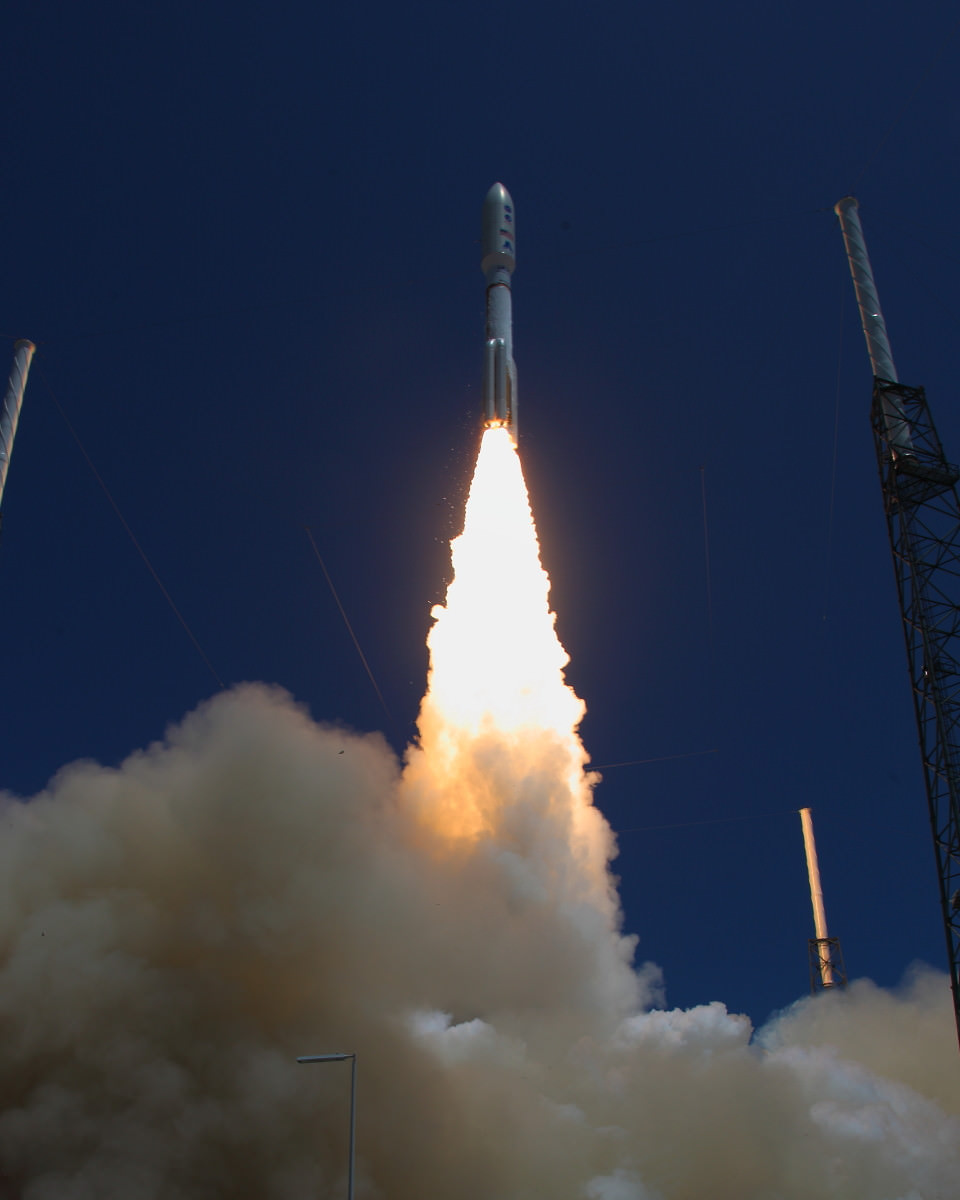
[/caption]
The Juno spacecraft, now safely on its way to the planet Jupiter, is carrying along with it several artifacts in honor of its voyage. Onboard the probe are three, tiny figurines of key players in the mythological and historical background of the gas giant. LEGO figurines of the Roman god Jupiter, his wife Juno and Italian astronomer Galileo Galilei have had their 1.5-inch likenesses added to the voyage.
In Roman mythology Jupiter had cast a veil of clouds over himself to hide his activities. Undeterred, his wife, Juno, peered through the clouds to see Jupiter’s true nature. Hence, her representation onboard the Juno spacecraft – is holding a spyglass. The last member of this odd ‘crew’ is Galileo, the man who made a number of important discoveries regarding the Jovian system.
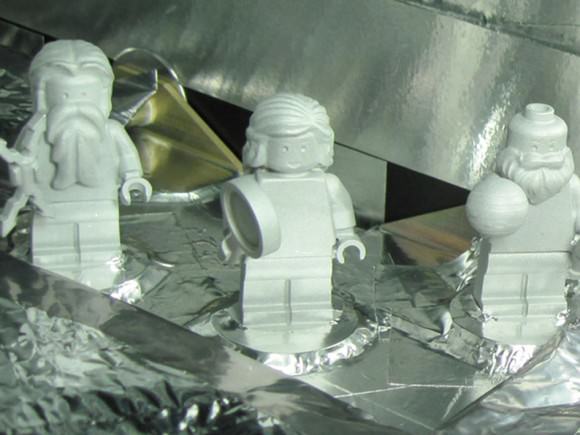
The inclusion of these three figures is part of a joint effort between NASA and the LEGO group to spark interest in Science, Technology, Engineering and Math or STEM in children. NASA went one step further in acknowledging the accomplishments of the man that made so many discoveries about this massive world. It has included a plaque in honor or Galileo.
During his life, Galileo contributed greatly to mankind’s understanding of the solar system. He discovered in 1610 what have since been dubbed the “Galilean moons” – Io, Europa, Ganymede and Callisto.

The plaque was donated by the Italian Space Agency and it measures 2.8 by 2 inches (71 by 51 millimeters). The plaque is manufactured from flight grade aluminum and weighs six grams or about 0.2 ounces. The plaque includes an illustration of the famous astronomer along with an inscription – in his own hand – a passage he made in 1610 concerning his observations of Jupiter. The inscription reads:
“On the 11th it was in this formation — and the star closest to Jupiter was half the size than the other and very close to the other so that during the previous nights all of the three observed stars looked of the same dimension and among them equally afar; so that it is evident that around Jupiter there are three moving stars invisible till this time to everyone.”
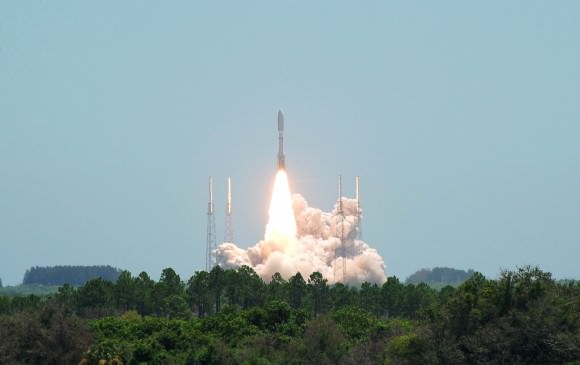
Juno successfully lifted off from Cape Canaveral Air Force Station’s Space Launch Complex 41 at 12:25 p.m. EDT on Friday, August 5. It will take the probe about five years to reach Jupiter. Once there it will enter in a polar orbit around the world where it will use its suite of instruments to peer beneath the veil of Jupiter’s clouds to study the planet’s gravity, magnetosphere and whether-or-not the planet has a rocky core.
NASA’s Jet Propulsion Laboratory (JPL) manages the Juno mission for the principal investigator, Scott Bolton, from the Southwest Research Institute in San Antonio. The Juno mission is part of the New Frontiers Program managed at NASA’s Marshall Space Flight Center in Huntsville, Ala. Lockheed Martin Space Systems, Denver, built the Juno spacecraft.
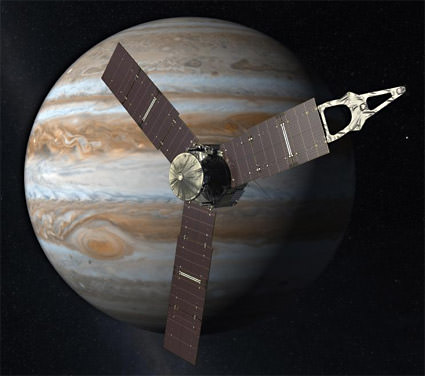
Opportunity Snaps Gorgeous Vistas nearing the Foothills of Giant Endeavour Crater
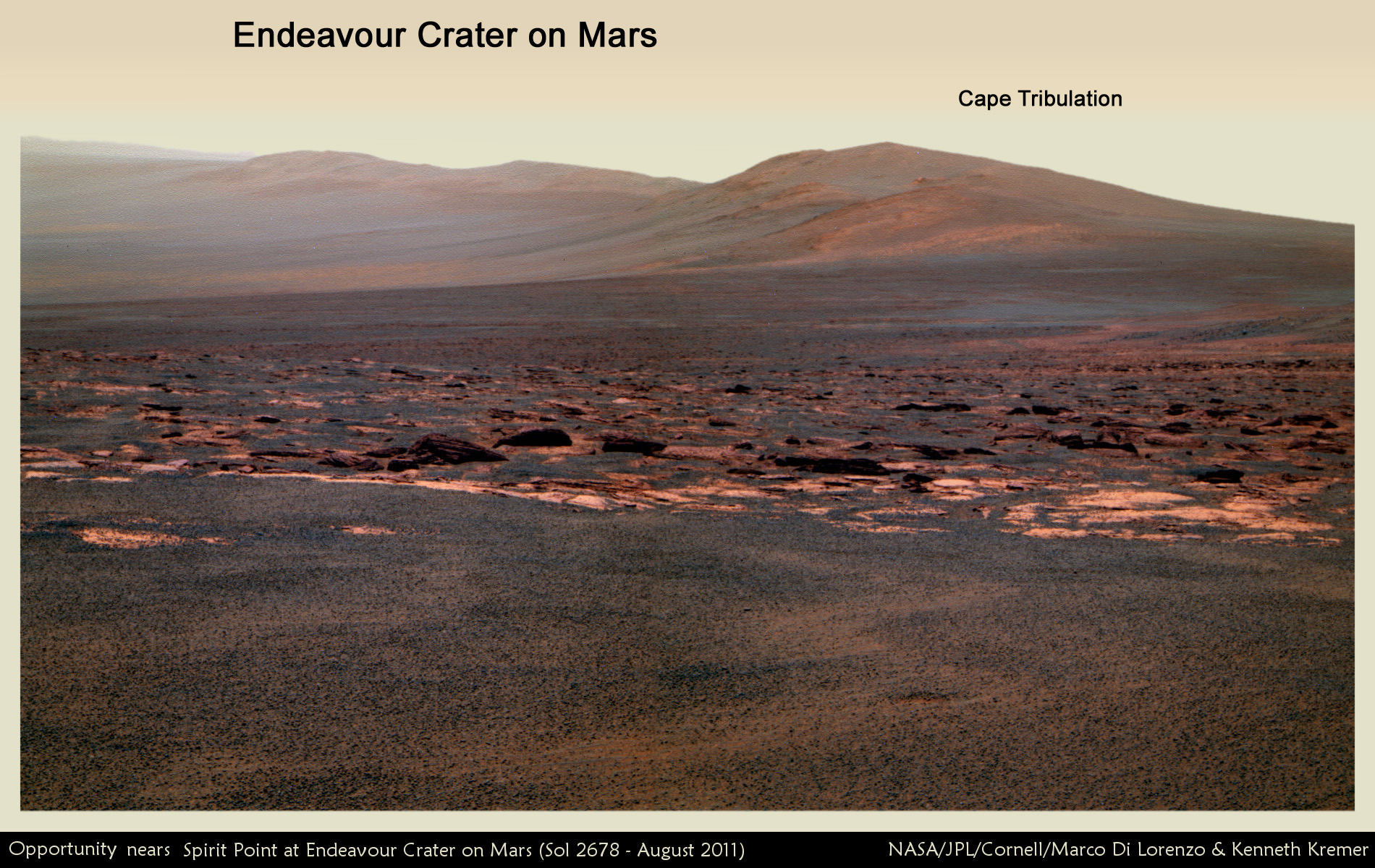
[/caption]
The epic multi-year trek of NASA’s Opportunity Mars rover to the gigantic Endeavour crater is nearly complete as the plucky rover blazes to within a football fields distance and first landfall at a spot dubbed “Spirit Point” – named in honor of her long lived twin sister “Spirit”. Endeavour beckons because it may hold clues to a time billions and billions of years ago when Mars was warmer and wetter and harbored an environment that was far more conducive to the formation of life beyond Earth.
Opportunity is racing towards the western foothills of Endeavour’s rim and is at long last transmitting stunningly clear images of portions of the crater ridges, revealing gorgeous vistas and intriguing details up the sloped walls. See our new photo mosaics above and below.
As of today, Aug. 8 on Sol 2680 of the mission, the Martian robot is less than 400 feet (150 m) away from Endeavour’s rim at Spirit Point – which lies at the southern tip of one of the ridges known as “Cape York,” on the western side of Endeavour (see map and photo below). The humongous crater is 14 miles (22 km) in diameter.
“Our primary goal is to get onto the older material at Cape York with the phyllosilicate signatures in CRISM,” said Dr. Matt Golembek in an interview with Universe Today. Golembek is a Senior Research Scientist with the Mars Exploration Program at the Jet Propulsion Laboratory (JPL) in Pasadena, Calif.
The phyllosilicate signatures are based on observations by the Compact Reconnaissance Imaging Spectrometer for Mars (CRISM) aboard NASA’s Mars Reconnaissance Orbiter (MRO). Phyllosilicates are clay minerals that form in the presence of neutral water and that are more far more hospitable to the possible genesis of life compared to the rocks studied from the more highly acidic aqueous environments examined by the rover thus far.
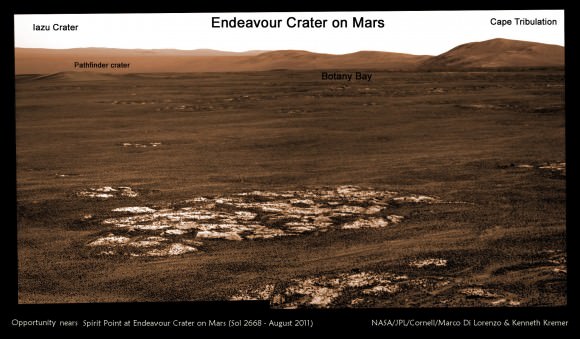
Opportunity was less than 0.3 miles (500 m) from the foothills of Endeavour Crater on Sol 2668 and will soon make first landfall at Spirit Point - off to the left. Endeavour holds minerals deposits from billions of years ago when Mars was far warmer and wetter and potentially more hospitable to the formation of ancient microbial life. This photo mosaic was stitched together to show portions of the discontinuous crater rim with segmented ridges from left to right. Distant Iazu crater is faintly visible at top left. Opportunity is now transmitting highly detailed and clear images of Endeavour’s rim.
Mosaic Credit: NASA/JPL/Cornell/Marco Di Lorenzo/Kenneth Kremer
In mid- 2008, Endeavour crater was chosen as the long term destination for Opportunity by the rover science team because it offers access to older geological deposits than any Opportunity has visited and investigated before. These mineral deposits include phyllosilicates.
Opportunity has been sprinting across the plains of Meridiani since departing her last major science stop at Santa Maria crater in March 2011. See our APOD here.
Opportunity is now heading to a spot called “Odyssey crater” on the way to Spirit Point. See JPL route map below.
“In the end of drive Navcams [navigation camera] from Sols 2678-9, large ejecta blocks on the rim of Odyssey crater are clearly visible and that is our next target to see what those blocks are made of,” Golembek told me.
“After that we will travel north into Cape York to better understand the older rocks in Cape York.”
The rover team is being very careful to not over plan the science activities to far in advance and are keeping their options open.
Eventually, Opportunity will scale the ridge and become the 2nd Martian mountain climber. Spirit was the first Earthly emissary to climb to the summit of a mountain on Mars.
“As we explore we will make more specific plans depending on what we see,” Golembek added.
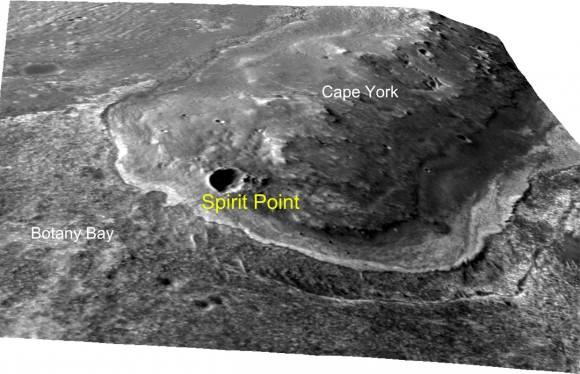
This oblique view with moderate vertical exaggeration shows the portion of the rim of Endeavour crater known as Spirit Point. The science and engineering team has driven Opportunity to a spot less than 400 feet from Spirit Point as of early August 2011. Credit: NASA/JPL-Caltech/Univ. of Arizona
Measurements from orbiting spacecraft like MRO allowed the science team to target Opportunity more precisely toward those ridges of older exposures of rock outcrops and phyllosilicates observed along Endeavour’s western rim.
Given Opportunity’s rapid progress, it’s now almost certain that she will reach the phyllosiliocates before the Curiosity rover is even launched in Nov. 2011.
Endeavour’s crater rim is discontinuous and divided into a series of segmented mountainous ridges – making it all the more beautiful and a bonanza for science. See the new photo mosaics above and below stitched together by Marco Di Lorenzo and Ken Kremer, illustrating Opportunity’s current vistas.
The Spirit rover succumbed to the bitter Martian arctic-like cold weather during her 4th winter on Mars after roving nearly seven years across Gusev crater. In May 2011, NASA declared Spirit’s mission had concluded after no further communications were received.
Opportunity remains healthy, generates sufficient solar power and has traversed an unbelievable 20.6 miles or 33.2 km since landing on Jan. 24, 2004.
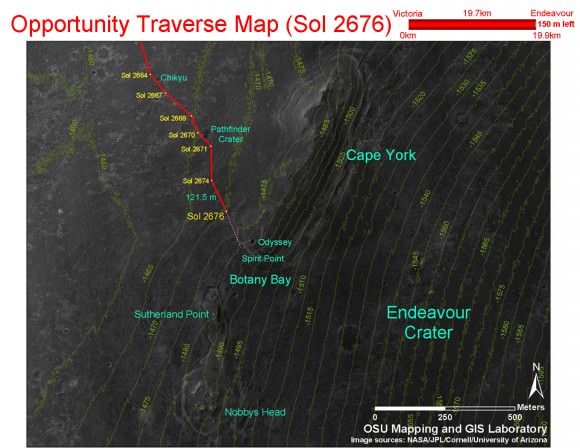
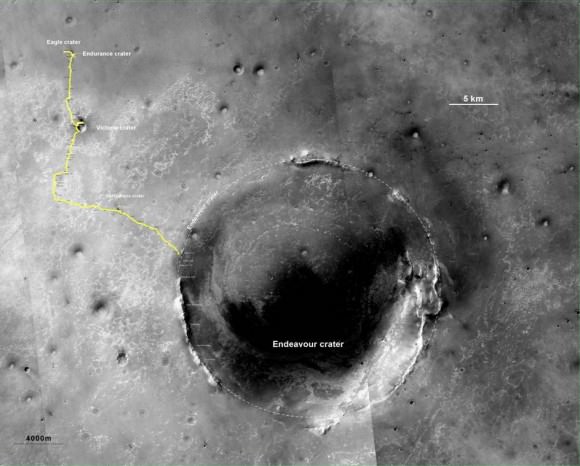
Read my continuing features about Mars starting here
Dramatic New NASA Animation Depicts Next Mars Rover in Action
Opportunity Rover Heads for Spirit Point to Honor Dead Martian Sister; Science Team Tributes
Opportunity Rover Completes Exploration of fascinating Santa Maria Crater
Opportunity Surpasses 30 KM Driving and Snaps Skylab Crater in 3 D
Rockin’ With the Juno Launch
Here’s a fantastic look at launch day for the Juno spacecraft, now on its way to Jupiter. It’s hard not to get pumped up for the mission after watching the Atlas V rocket blast into space, sending Juno on its journey. This video is courtesy the United Launch Alliance (ULA). Universe Today will have more original videos from launch day soon from our team of photographers and videographers who were on hand at Kennedy Space Center.
A Noctilucent Masterpiece
[/caption]
Night-shining “noctilucent” clouds create a magical glow in the night skies over Reykjavíc, Iceland in this beautiful photo by Örvar Atli Þorgeirsson, taken on August 6. In the foreground is “The Sun Voyager” (Sólfar), an iconic steel sculpture located on the city waterfront representing a Viking ship.
Örvar did not set out to photograph this rare atmospheric phenomenon but had instead intended to shoot aurora triggered by recent solar outbursts.
“The forecast on the 6th of August was predicting extreme aurora activity,” Örvar says in his Flickr description. “Even though it was very early August and the night would not get fully dark I went out as the aurora can be seen in deep twilight conditions. I saw the aurora for 1 – 2 minutes that night. I did not get a good picture of it though. Instead we witnessed this even rarer phenomenon called noctilucent clouds.”
Noctilucent clouds are extremely high-level clouds made located in the mesosphere, around 76 to 85 kilometers (47 to 53 miles) high… nearly at the very edge of space. (Most commercial airplanes fly between 6 and 7 miles high.) They are high enough to reflect sunlight coming from beyond the horizon long after night has fallen over the land below. They usually appear as a wispy web of blue, white, purple and orange tendrils stretched across the sky.
“These clouds where extremely beautiful to look at and reminded me of the aurora but where much more stationary and had this beautiful blue color.”
– Örvar Atli Þorgeirsson
Noctilucent clouds are mainly visible at latitudes between 50º – 70º north and south during the months of June and July. This means Reykjavíc, located right in the middle, can get great views. (Of course it helps to have a talented photographer like Örvar to capture them so nicely!)
Oddly enough noctilucent clouds are a relatively recent phenomenon, only having been recorded for about 120 years. They have been connected with space shuttle passages through the upper atmosphere, and it’s even been suggested that they may be associated with the 1908 Tunguska impact.
Read more about noctilucent clouds here.
Image © Örvar Atli Þorgeirsson. All rights reserved. Used with permission.
_____________________
Jason Major is a graphic designer, photo enthusiast and space blogger. Visit his website Lights in the Dark and follow him on Twitter @JPMajor or on Facebook for the most up-to-date astronomy news and images!
How Big Are Solar Flares?
With the recent activity on the Sun, we’ve used the words “massive” or “huge” to describe solar flares. But just how big are they, really? This great video explains and illustrates the actual size of solar flares.
Thanks to Scott Stevenson for creating and sending us the video. Scott notes that text subtitles are available if you click on the “CC” button on the bottom of the video screen, making this informative video accessible to a wider audience.
Searching For Gravitational Waves
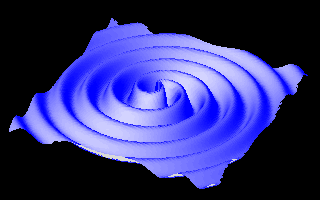
[/caption]Colliding neutron stars and black holes, supernova events, rotating neutron stars and other cataclysmic cosmic events… Einstein predicted they would all have something in common – oscillations in the fabric of space-time. This summer European scientists have joined forces to prove Einstein was right and capture evidence of the existence of gravitational waves.
Europe’s two ground-based gravitational wave detectors GEO600 (a German/UK collaboration) and Virgo (a collaboration between Italy, France, the Netherlands, Poland and Hungary) are underway with a joint observation program which will continue over the summer, ending in September 2011. The detectors consist of a pair of joined arms placed in a horizontal L-shaped configuration. Laser beams are then passed down the arms. Suspended under vacuum at the ends of the arms is a mirror which returns the beam to a central photodetector. The detectors work by measuring tiny changes (less than the diameter of a proton), caused by a passing gravitational wave, in the lengths (hundreds or thousands of meters). The periodic stretching and shrinking of the arms is then recorded as interference patterns.
Much like our human ears are able to distinguish the direction of sound from being spaced apart, so having interferometers placed at different locations benefits the chances of picking up a gravitational wave signal. By placing receivers at a distance, this also helps to eliminate the chances of picking up a mimicking terrestrial signal, since it would be unlikely for it to have the same characteristics at two locations while a genuine signal would remain the same.
“If you compare GEO600 and Virgo, you can see that both detectors have similar sensitivities at high frequencies, at around 600Hz and above”, says Dr Hartmut Grote, a scientist at the Max Planck Institute for Gravitational Physics (Albert Einstein Institute/AEI) and the Leibniz University in Hannover, Germany. “That makes it very interesting for us to search this band for possible gravitational waves associated with supernovae or gamma-ray bursts that are observed with conventional telescopes.”
Of all phenomena, gamma-ray bursts are expected to be one of the strongest sources of gravitational waves. As the most luminous transient event in the known Universe, this collapse of a supermassive star core into a neutron star or black hole may be the most perfect starting point for the search. As of now, the frequencies will depend on the mass and may extend up to the kHz band. But don’t get too excited, because the nature of gravitational wave signals is weak and chances of picking up on it is low. However, thanks to Virgo’s excellent sensitivity at low frequencies (below 100 Hz), it is a prime candidate for gathering signals from isolated pulsars where the gravitational wave signal frequency should be at around 22Hz.
And we’ll be listening for the results…
Original Story Source: Albert Einstein Institute News.
Cassini Focuses In On Two Moons
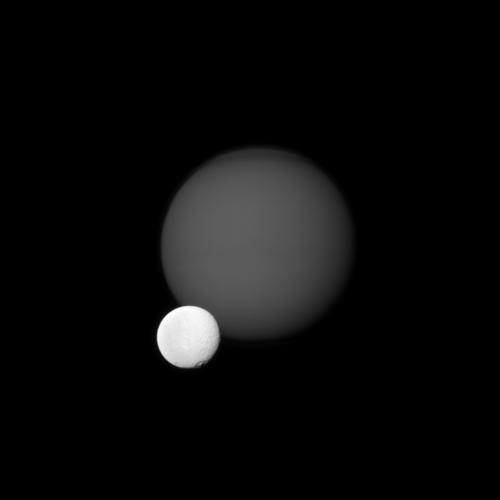
[/caption]
In this new image from the Cassini Imaging Team Saturn’s moon Titan looks a little out of focus compared to the sharp, cratered surface of Tethys, seen in the foreground. But that’s only because Titan’s hazy atmosphere makes the moon look blurry. Titan’s current atmosphere is thought to resemble Earth’s early atmosphere, so we could be looking at an analog of early Earth.
And so, the Cassini mission is sharpening our understanding of Saturn and all its moons, but it might help us understand our own planet, as well.
At just over 1,000 kilometers in diameter, Tethys is believed to be almost entirely comprised of water ice, based on density estimates. Titan, at just over 5,000 kilometers in diameter is notable for being the second largest moon in our solar system, as well as having an atmosphere 1 1/2 times thicker than Earth. Titan is also known to have an active “liquid cycle” made up of various hydrocarbons, making Titan the second body in the solar system to have stable liquid on its surface.
The camera view is aimed at the Saturn-facing side of Titan and at the area between the trailing hemisphere and anti-Saturn side of Tethys. Not shown in frame is Saturn, which would be far to the left, from the perspective shown in the image.
The image was acquired with Cassini’s narrow-angle camera, in green visible light, on July 14, 2011. At a distance of roughly 3 million kilometers, the image scale for Titan is 19 kilometers per pixel. With Tethys at a distance of about 2 million kilometers, the image scale is roughly 11 kilometers per pixel.
If you’d like to learn more about the extended Cassini “solstice” mission, you can read more at: http://saturn.jpl.nasa.gov/mission/introduction/
Source: Cassini Solstice Mission Images

